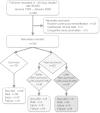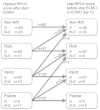Acute kidney injury is a frequent complication in critically ill neonates receiving extracorporeal membrane oxygenation: a 14-year cohort study
- PMID: 23883698
- PMCID: PMC4057448
- DOI: 10.1186/cc12830
Acute kidney injury is a frequent complication in critically ill neonates receiving extracorporeal membrane oxygenation: a 14-year cohort study
Abstract
Introduction: Newborns in need of extracorporeal membrane oxygenation (ECMO) support are at high risk of developing acute kidney injury (AKI). AKI may occur as part of multiple organ failure and can be aggravated by exposure to components of the extracorporeal circuit. AKI necessitates adjustment of dosage of renally eliminated drugs and avoidance of nephrotoxic drugs. We aimed to define systematically the incidence and clinical course of AKI in critically ill neonates receiving ECMO support.
Methods: This study reviewed prospectively collected clinical data (including age, diagnosis, ECMO course, and serum creatinine (SCr)) of all ECMO-treated neonates within our institution spanning a 14-year period. AKI was defined by using the Risk, Injury, Failure, Loss of renal function, and End-stage renal disease (RIFLE) classification. SCr data were reviewed per ECMO day and compared with age-specific SCr reference values. Accordingly, patients were assigned to RIFLE categories (Risk, Injury, or Failure as 150%, 200%, or 300% of median SCr reference values). Data are presented as median and interquartile range (IQR) or number and percentage.
Results: Of 242 patients included, 179 (74%) survived. Median age at the start of ECMO was 39 hours (IQR, 26 to 63); median ECMO duration was 5.8 days (IQR, 3.9 to 9.4). In total, 153 (64%) patients had evidence of AKI, with 72 (30%) qualifying as Risk, 55 (23%) as Injury, and 26 (11%) as Failure. At the end of the study period, only 71 (46%) patients of all 153 AKI patients improved by at least one RIFLE category. With regression analysis, it was found that nitric oxide ventilation (P = 0.04) and younger age at the start of ECMO (P = 0.004) were significant predictors of AKI. Survival until intensive care unit discharge was significantly lower for patients in the Failure category (35%) as compared with the Non-AKI (78%), Risk (82%), and Injury category (76%), with all P < 0.001, whereas no significant differences were found between the three latter RIFLE categories.
Conclusions: Two thirds of neonates receiving ECMO had AKI, with a significantly increased mortality risk for patients in the Failure category. As AKI during childhood may predispose to chronic kidney disease in adulthood, long-term monitoring of kidney function after ECMO is warranted.
Figures




Comment in
-
Acute kidney injury: the dilemma of organ failures or just a circular reference?Crit Care. 2013 Sep 4;17(5):182. doi: 10.1186/cc12873. Crit Care. 2013. PMID: 24004473 Free PMC article.
References
-
- Michel CC. Transport of macromolecules through microvascular walls. Cardiovasc Res. 1996;17:644–653. - PubMed
-
- Stahl RF, Fisher CA, Kucich U, Weinbaum G, Warsaw DS, Stenach N, O'Connor C, Addonizio VP. Effects of simulated extracorporeal circulation on human leukocyte elastase release, superoxide generation, and procoagulant activity. J Thorac Cardiovasc Surg. 1991;17:230–239. - PubMed
-
- Alkandari O, Eddington KA, Hyder A, Gauvin F, Ducruet T, Gottesman R, Phan V, Zappitelli M. Acute kidney injury is an independent risk factor for pediatric intensive care unit mortality, longer length of stay and prolonged mechanical ventilation in critically ill children: a two-center retrospective cohort study. Crit Care. 2011;17:R146. doi: 10.1186/cc10269. - DOI - PMC - PubMed
Publication types
MeSH terms
LinkOut - more resources
Full Text Sources
Other Literature Sources
Medical
Research Materials

